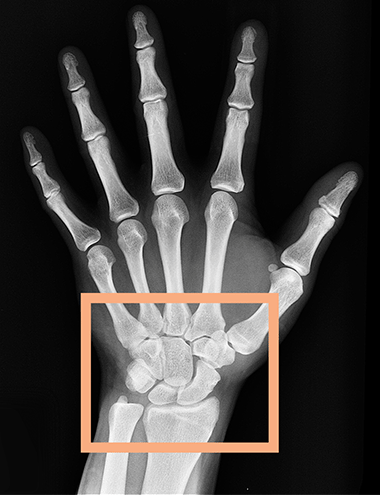Wrist Fracture or Sprain?
You tripped and fell and landed on a hard surface with your arms outstretched. Nothing feels broken, but you do feel some pain in the wrist area: How can you tell if you have a wrist fracture (medical term for broken wrist) or a wrist sprain?
 The wrist is a network of many bones and joints. It consists of eight carpal (wrist) bones, five metacarpals (hand) bones and two forearm bones; the radius and ulna. It is the hub to over twenty joints that are held together by ligaments, which makes it a very intricate and complex union.
The wrist is a network of many bones and joints. It consists of eight carpal (wrist) bones, five metacarpals (hand) bones and two forearm bones; the radius and ulna. It is the hub to over twenty joints that are held together by ligaments, which makes it a very intricate and complex union.
When a fall or forceful impact occurs, it’s a common reaction to stretch your arms out to brace yourself from the impact. By doing so, you’re hands and wrists become vulnerable to injury, often resulting in hand, wrist or upper extremity fractures or injuries. If a severe fracture happens, it can easily be detected by the deformity of the wrist and/or bones that may be protruding through the skin. However, in some fractures and injuries it is difficult to determine what the injury really is. In fractures and sprains alike, pain levels can vary, and symptoms are often very similar. If pain is moderate and no symptoms are visible, it is often thought that the injury is merely a sprain; however, that is not always the case. The information below provides wrist fracture and wrist sprain symptoms which aide in diagnosis:
| Wrist Fracture | Wrist Sprain |
| Wrist pain – with movement or touch pain may increase | Wrist pain– intermittent to dull aches to sharp constant pain. |
| Decreased mobility – decreased hand and wrist mobility | Joint weakness – limited strength and movement |
| Swelling and possible deformity of the wrist | Swelling – the amount of swelling usually depends on the severity |
| Stiffness – Finger, hand and wrist stiffness | Stiffness – lack of mobility to the wrist joint |
| Numb or tingling fingers | Bruising of the wrist or surrounding area |
If you suspect your injury is a sprain, the pain and swelling should be minimal and will most likely subside after a few days. However, if the pain continues or increases, and the lack of mobility affects your everyday use, an x-ray may be warranted to determine if your wrist is fractured or not. Actually, ruling out a fracture can be just as important as diagnosing one.
X-rays are fairly simple and often accurate at showing if a fracture exists. If a fracture is diagnosed or undetermined, wrist injuries are often referred to a hand specialist or hand surgeon due to the intricate components of the wrist. Depending on the severity of the injury, icing, immobilization, splinting, casting or surgery may be options discussed with your hand specialist.
Leave a Reply